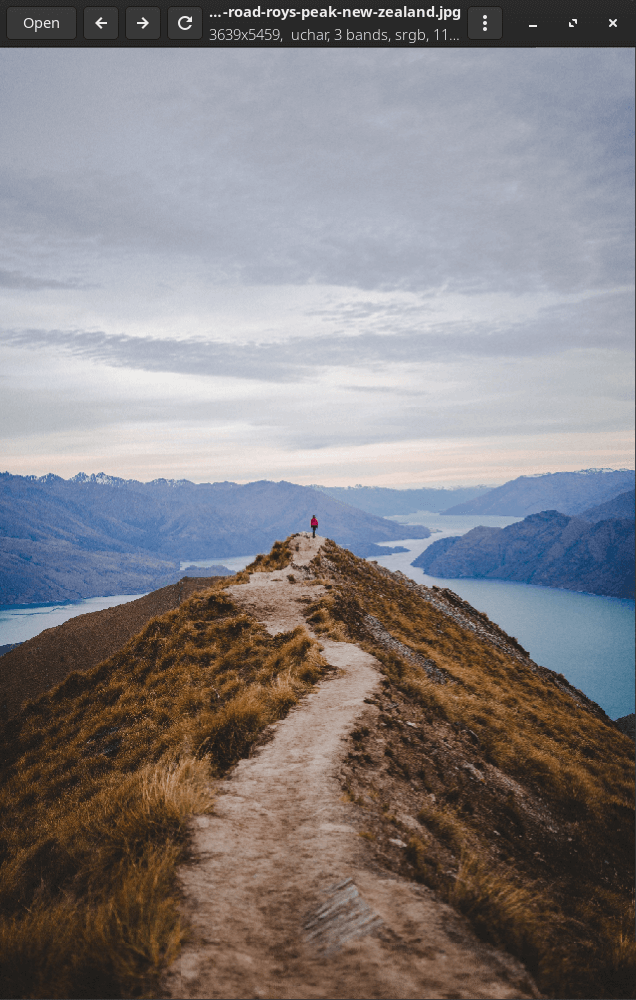vipsdisp is a tiny libvips / GTK+4 image viewer.
It can display huge (many, many GB) images quickly and without consuming much memory.
This is free and open source software.
Features include:
- Supports many scientific and technical image formats, including TIFF, WEBP, JP2K, JXL, AVIF, HEIC, PNG, JPEG, SVS, MRXS, OpenEXR, GIF, PDF, SVG, FITS, Matlab, NIfTI, Analyze, etc.
- Supports pixel types from 1 bit mono to 128-bit double precision complex.
- Doesn’t need to keep the whole image in memory. It will only read parts that it needs for display, and it understands most pyramidal image formats. This means you can open and view huge images quickly.
- Threaded, asynchronous display repaint, so pixels are computed in the background by a pool of workers. The interface stays live even under very heavy load.
- Keeps a sparse pyramid of computed tiles as textures on the GPU. Each frame, it computes the set of visible tiles, and then the GPU scales, positions and composites just those tiles to the screen. CPU load should be low (except for the background workers heh). Hold down i (for “in”) or + to do a smooth zoom on the cursor. If you press “d” it toggles a debug display mode which shows the tiles being computed.
- Select Display control bar from the top-right menu and a useful set of visualization options appear. It supports four main display modes: Toilet roll (sorry), Multipage, Animated, and Pages as Bands.
- In Toilet roll mode, a multi-page image is presented as a tall, thin strip of images. In Multipage, you see a single page at a time, with a page-select spinner (you can also use the
crtl-<andctrl->keys to flip pages). In animated mode, pages flip automatically on a timeout. In pages-as-bands mode, many-page single-band images (eg. OME-TIFF) are presented as a single colour image. - Select falsecolour and log-scale filters, useful for many scientific images. Scale and offset sliders let you adjust image brightness to see into darker areas (useful for HDR and many scientific images).
- Select Save as to write an image. It can write most common formats, and lets you set file save options. It can write things like DeepZoom pyramids, PFM, OpenEXR, and so on.
- Select Properties (alt-Enter) to see image metadata. It can display large amounts of metadata (useful for eg. DICOM) with filtering.
- Use alt-Left and alt-Right to move between the set of images being displayed, handy for browsing a directory of images. If you drag or load a set of images, it’ll flip between the images in the set. If you drag or load a single image, it’ll flip between all the images in that directory.
- Keeps the most recent three views live, so you can flip between them very quickly, and all view settings are preserved. This is handy for comparing details on two images.
Duplicate windowcrtl-D makes a copy of the window, so you can compare two images side by side.- Supports copy/paste and drag/drop of filenames, sets of filenames, and textures. You can paste from the screenshot tool, or drag-drop images from your file browser, for example.
- Uses the GTK4 GUI toolkit, so the interface is fast, attractive and nicely animated. The image is rendered with the GPU, so display ought to be quick.
Website: github.com/jcupitt/vipsdisp
Support:
Developer: John Cupitt
License: MIT License

vipsdisp is written in C. Learn C with our recommended free books and free tutorials.
| Popular series | |
|---|---|
| The largest compilation of the best free and open source software in the universe. Each article is supplied with a legendary ratings chart helping you to make informed decisions. | |
| Hundreds of in-depth reviews offering our unbiased and expert opinion on software. We offer helpful and impartial information. | |
| The Big List of Active Linux Distros is a large compilation of actively developed Linux distributions. | |
| Replace proprietary software with open source alternatives: Google, Microsoft, Apple, Adobe, IBM, Autodesk, Oracle, Atlassian, Corel, Cisco, Intuit, and SAS. | |
| Awesome Free Linux Games Tools showcases a series of tools that making gaming on Linux a more pleasurable experience. This is a new series. | |
| Machine Learning explores practical applications of machine learning and deep learning from a Linux perspective. We've written reviews of more than 40 self-hosted apps. All are free and open source. | |
| New to Linux? Read our Linux for Starters series. We start right at the basics and teach you everything you need to know to get started with Linux. | |
| Alternatives to popular CLI tools showcases essential tools that are modern replacements for core Linux utilities. | |
| Essential Linux system tools focuses on small, indispensable utilities, useful for system administrators as well as regular users. | |
| Linux utilities to maximise your productivity. Small, indispensable tools, useful for anyone running a Linux machine. | |
| Surveys popular streaming services from a Linux perspective: Amazon Music Unlimited, Myuzi, Spotify, Deezer, Tidal. | |
| Saving Money with Linux looks at how you can reduce your energy bills running Linux. | |
| Home computers became commonplace in the 1980s. Emulate home computers including the Commodore 64, Amiga, Atari ST, ZX81, Amstrad CPC, and ZX Spectrum. | |
| Now and Then examines how promising open source software fared over the years. It can be a bumpy ride. | |
| Linux at Home looks at a range of home activities where Linux can play its part, making the most of our time at home, keeping active and engaged. | |
| Linux Candy reveals the lighter side of Linux. Have some fun and escape from the daily drudgery. | |
| Getting Started with Docker helps you master Docker, a set of platform as a service products that delivers software in packages called containers. | |
| Best Free Android Apps. We showcase free Android apps that are definitely worth downloading. There's a strict eligibility criteria for inclusion in this series. | |
| These best free books accelerate your learning of every programming language. Learn a new language today! | |
| These free tutorials offer the perfect tonic to our free programming books series. | |
| Linux Around The World showcases usergroups that are relevant to Linux enthusiasts. Great ways to meet up with fellow enthusiasts. | |
| Stars and Stripes is an occasional series looking at the impact of Linux in the USA. | |
